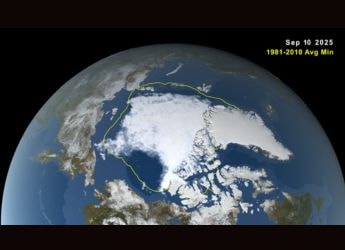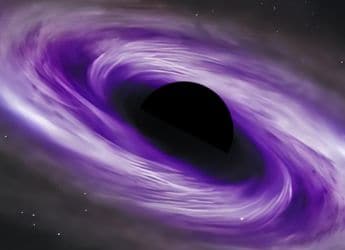- Home
- Science
- Science News
- Satellite Observations Record Arctic Sea Ice at Lowest Level of the Year
Satellite Observations Record Arctic Sea Ice at Lowest Level of the Year
Arctic sea ice reached 1.78 million sq miles in 2025, tying the 10th-lowest extent on record. Antarctic ice also stayed below average, reinforcing evidence of polar climate change.

Photo Credit: NASA
Arctic Sea Ice Reaches Annual Low
Arctic sea ice recedes to summer minimum each year and then starts to grow in the winter. The lowest extent was observed in 2025 with satellite observations that were made in almost fifty years of monitoring. On September 10, the lowest ice-cover was 1.78 million square miles, the tenth-lowest in history. Although not a record, the outcome sets an emerging trend of decreasing coverage in the Arctic due to increasing temperatures in the world. Conversely, Antarctic sea ice which is now close to its winter peak is still low seasonally.
Arctic Decline
According to studies, there is an evident negative trend in the Arctic sea ice since the onset of continuous satellite surveillance in 1978. This long-term decrease includes the 2025 minimum, although it is not remarkable. NASA scientists claim that the general trend is the uniform warming of the area. The minimum recorded was in 2012, when an abnormal warmth and weather drove the coverage to 1.31 million square miles. Summer ice levels have remained significantly lower than those before 2007, highlighting the way that the Arctic has continued to get thin and brittle over the last 19 years.
Antarctic irregularity
The history of the sea ice in the Southern Hemisphere in the Antarctic is more complex. The winter peak of the year is lower than the historical average, however, the long-term trends are often hidden under local winds and weather. Perspective is provided by satellites that can capture the natural swings as well as dramatic lows over a period of 47 years. Since it allows them to differentiate the variability on an annual basis and the greater signal of a planet that is becoming warmer, scientists emphasize the relevance of this archive. They indicate that the 2025 minimum is another indication that the icy borders of earth are shifting very much and forever.
For the latest tech news and reviews, follow Gadgets 360 on X, Facebook, WhatsApp, Threads and Google News. For the latest videos on gadgets and tech, subscribe to our YouTube channel. If you want to know everything about top influencers, follow our in-house Who'sThat360 on Instagram and YouTube.
Related Stories
- Samsung Galaxy Unpacked 2025
- ChatGPT
- Redmi Note 14 Pro+
- iPhone 16
- Apple Vision Pro
- Oneplus 12
- OnePlus Nord CE 3 Lite 5G
- iPhone 13
- Xiaomi 14 Pro
- Oppo Find N3
- Tecno Spark Go (2023)
- Realme V30
- Best Phones Under 25000
- Samsung Galaxy S24 Series
- Cryptocurrency
- iQoo 12
- Samsung Galaxy S24 Ultra
- Giottus
- Samsung Galaxy Z Flip 5
- Apple 'Scary Fast'
- Housefull 5
- GoPro Hero 12 Black Review
- Invincible Season 2
- JioGlass
- HD Ready TV
- Laptop Under 50000
- Smartwatch Under 10000
- Latest Mobile Phones
- Compare Phones
- Samsung Galaxy A17 4G
- Redmi 15C 5G
- Oppo K13s
- Redmi 15R 5G
- Vivo Y31 Pro 5G
- Vivo Y31 5G
- Oppo F31 5G
- Oppo F31 Pro 5G
- Acer Nitro V 16S (2025)
- Acer Nitro V 16 (2025)
- Moto Pad 60 Neo
- Xiaomi Moaan InkPalm Mini Plus 2
- Garmin Instinct Crossover AMOLED
- Garmin Venu 4
- Elista QLED Google TV
- TCL C72K QD Mini‑LED TV
- Asus ROG Ally
- Nintendo Switch Lite
- Haier 1.6 Ton 5 Star Inverter Split AC (HSU19G-MZAID5BN-INV)
- Haier 1.6 Ton 5 Star Inverter Split AC (HSU19G-MZAIM5BN-INV)

















